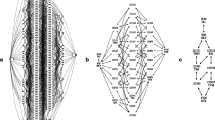Abstract
Nucleotide sequences are often generated by Monte Carlo simulations to address complex evolutionary or analytic questions but the simulations are rarely described in sufficient detail to allow the research to be replicated. Here we briefly review the Markov processes of substitution in a pair of matching (homologous) nucleotide sequences and then extend it to k matching nucleotide sequences. We describe calculation of the joint distribution of nucleotides of two matching sequences. Based on this distribution, we give a method for simulation of the divergence matrix for n sites using the multinomial distribution. This is then extended to the joint distribution for k nucleotide sequences and the corresponding 4k divergence array, generalizing Felsenstein (Journal of Molecular Evolution, 17, 368–376, 1981), who considered stationary, homogeneous and reversible processes on trees. We give a second method to generate matched sequences that begins with a random ancestral sequence and applies a continuous Markov process to each nucleotide site as in Rambaut and Grassly (Computer Applications in the Biosciences, 13, 235–238, 1997); further, we relate this to an equivalent approach based on an embedded Markov chain. Finally, we describe an approximate method that was recently implemented in a program developed by Jermiin et al. (Applied Bioinformatics, 2, 159–163, 2003). The three methods presented here cater for different computational and mathematical limitations and are shown in an example to produce results close to those expected on theoretical grounds. All methods are implemented using functions in the S-plus or R languages.
Similar content being viewed by others
References
Benson, D. A., Karsch-Mizrachi, I., Lipman, D. J., Ostell, J., Rapp, B. A. and Wheeler, D. L.: GenBank, Nucleic Acids Res. 28 (2000), 15–18
Conant, G. C. and Lewis, P. O.: Effects of nucleotide compositional bias in the success of the parsimony criterion in phylogenetic inference, Mol. Biol. Evol. 18 (2001), 1024–1033.
Felsenstein, J.: Evolutionary trees from DNA sequences: A maximum likelihood approach, J. Mol. Evol. 17 (1981), 368–376.
Felsenstein, J.: Inferring Phylogenies, Sinauer, Sunderland, Massachusetts, USA, 2004.
Felsenstein, J.: PHYLIP (Phylogeny Inference Package), version 3.62, Distributed by the author. Department of Genome Sciences, University of Washington, Seattle, 2004.
Gaut, B. S. and Lewis, P. O.: Success of maximum likelihood phylogeny inference in the four-taxon case, Mol. Biol. Evol. 12 (1995), 152–162.
Ho, S. Y. W. and Jermiin, L. S.: Tracing the decay of the historical signal in biological sequence data, Syst. Biol. 53 (2004), 623–637.
Jermiin, L. S., Ho, S. Y. W., Ababneh, F., Robinson, J. and Larkum, A. W. D.: Hetero: A program to simulate the evolution of DNA on a four-taxon tree, Appl. Bioinformatics 2 (2003), 159–163.
Jermiin, L. S., Ho, S. Y. W., Ababneh, F., Robinson, J. and Larkum, A. W. D.: The biasing effect of compositional heterogeneity on phylogenetic estimates may be underestimated. Syst. Biol. 53 (2004), 638–643.
Lake, J. A.: Reconstructing evolutionary trees from DNA and protein sequences: Paralinear distances. Proc. Natl. Acad. Sci. USA. 91 (1994), 1155–1159.
Lockhart, P. J., Steel, M. A., Hendy, M. D. and Penny, D.: Recovering evolutionary trees under a more realistic model of sequence evolution, Mol. Biol. Evol. 11 (1994), 605–612.
Rambaut, A. and Grassly, N. C.: Seq-Gen: An application for the Monte Carlo simulation of DNA sequence evolution along phylogenetic trees, Comput. Appl. Biosci. 13 (1997), 235–238.
Swofford, D. L., Olsen, G. J., Waddell, P. J. and Hillis, D. M.: Phylogenetic inference, in D. M. Hillis, D. Moritz and B. K. Mable (eds), Molecular Systematics, 2nd Edn., Sinauer, Sunderland, Massachusetts, USA, 1996, pp. 407–514.
Tavaré, S.: Some probabilistic and statistical problems on the analysis of DNA sequences, Lect. Math. Life Sci. 17 (1986), 57–86.
Van, Den Bussche, R. A., Baker, R. J., Huelsenbeck, J. P. and Hillis, D. M.: Base compositional bias and phylogenetic analyses: A test of the “flying DNA” hypothesis, Mol. Phylogenet. Evol. 10 (1998), 408–416.
Zharkikh, A.: Estimation of evolutionary distances between nucleotide sequences, J. Mol. Evol. 39 (1994), 315–329.
Author information
Authors and Affiliations
Corresponding author
Rights and permissions
About this article
Cite this article
Ababneh, F., Jermiin, L.S. & Robinson, J. Generation of the Exact Distribution and Simulation of Matched Nucleotide Sequences on a Phylogenetic Tree. J Math Model Algor 5, 291–308 (2006). https://doi.org/10.1007/s10852-005-9017-y
Published:
Issue Date:
DOI: https://doi.org/10.1007/s10852-005-9017-y




